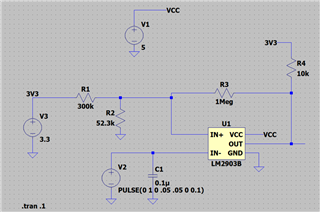Other Parts Discussed in Thread: LM111
Dear Team,
I was seeing a comparator circuit designed with LM2903. The circuit diagram is given below. It is working as expected in simulation.
In the feedback path you can see a 1 MΩ resistor.
My questions are:
-
Is it a good idea to put large resistors in feedback path?
-
Will this increase the noise pick up, because a large resistor in feedback path creates a high impedance node.

Everything works perfectly on a LTspice, but I wanted to check a few things before finalizing the board layout, and came across a TI application note which says in paragraph 6:
However, it doesn't say why a high value feedback resistor is "not reasonable".
I can definitely see good hysteresis behavior's with the 1M resistor in simulation
So, what is the drawback of High value resistor?

